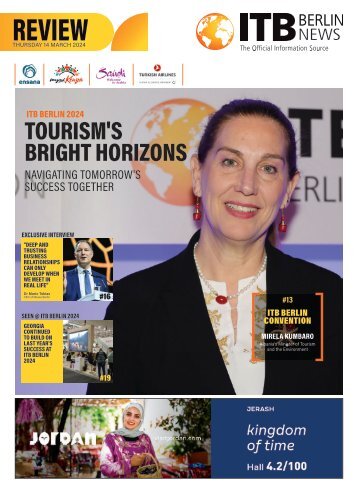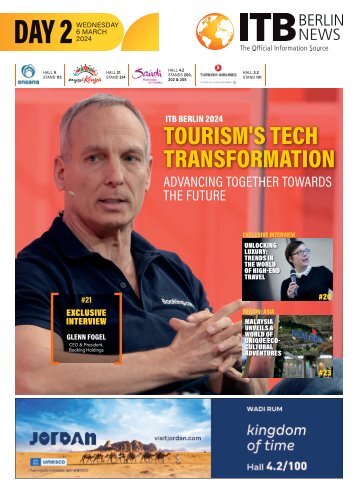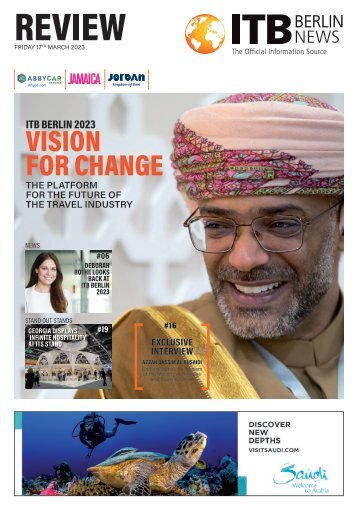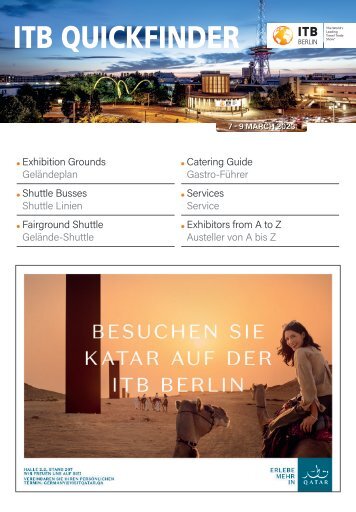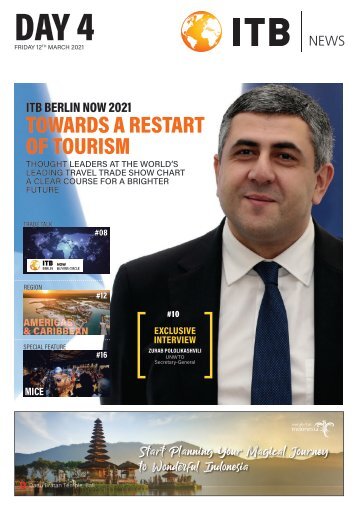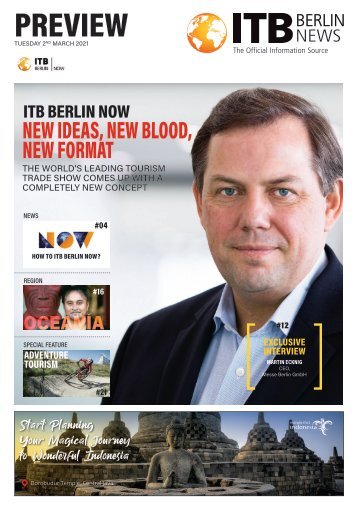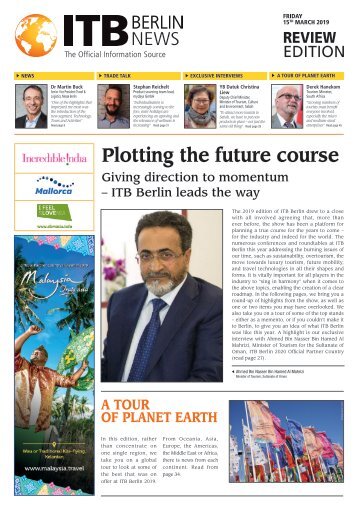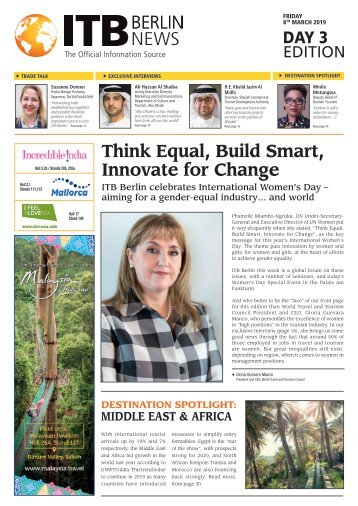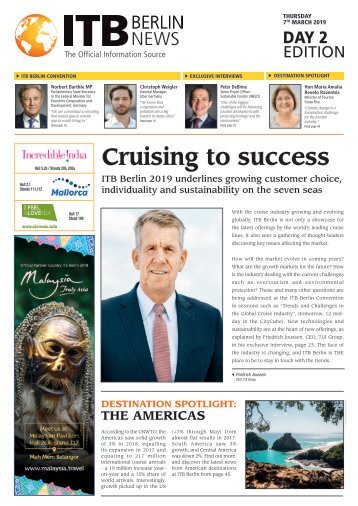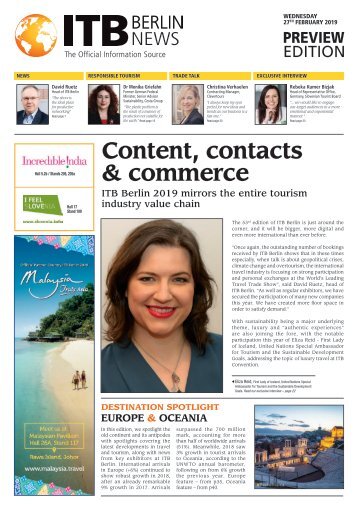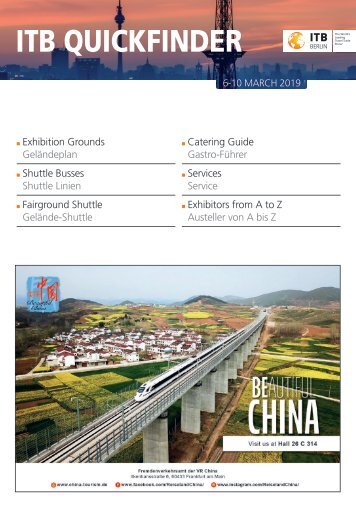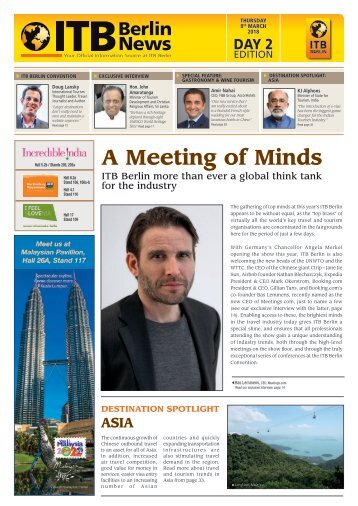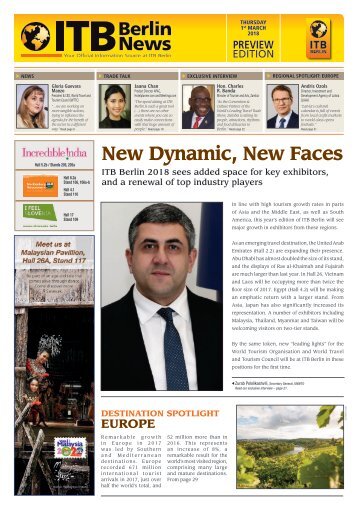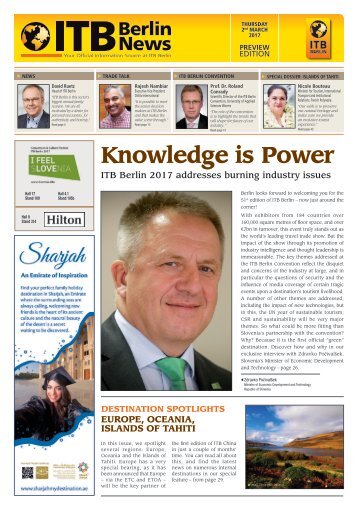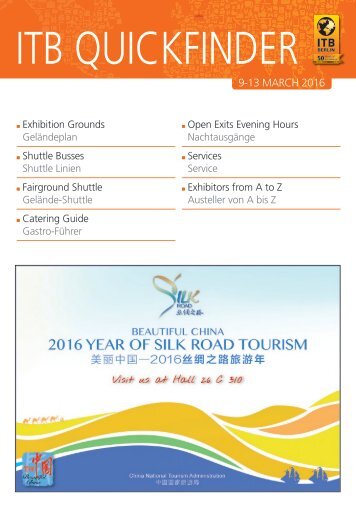
ITB Berlin News 2021 - Day 1 Edition
- Text
- Martinique
- Region
- Global
- Heritage
- European
- Destination
- Saxony
- Cultural
- Berlin
- Tourism
I REGION I SAXONY I
I REGION I SAXONY I ADVERTORIAL NEW MOUNTAIN BIKE TRAILS IN SAXONY Saxony's reputation as a mountain biking paradise is gaining pace in the MTB scene with the Ore Mountains no longer the mountain bikers' best kept secret. We asked Ronny Schwarz, in charge of active tourism product development for the Ore Mountains Tourism Association what is behind the success. We recently created attractive MTB offers throughout the Ore Mountains. As a low mountain range, the "Erzgebirge" offers great biking action, breathtaking nature and great freedom. We have an exceptional offer in the MTB sector with the Stoneman Miriquidi, the TrailCenter Rabenberg and the Bikerevier. We are now working on the "8,000 Blockline" – a mountain bike highlight linking the "toy city" Seiffen and the winter sports resort of Altenberg. What is behind the Blockline? The Blockline will be a mountain bike trail for sporty families with children from the age of eight. We are creating a 140-km long biking experience in the Seiffen/Mulda/Altenberg triangle. On three exciting loop trails, bikers will discover the pristine nature of the Eastern Ore Mountains. Why is the Blockline so special? Along the Blockline, we installed huge wooden portals which give information about our region and point the way to impressive panoramas, curious rock formations, lush meadows and serene streams. There is a panoramic view of the Schwartenberg and water mills along the Gimmlitz, with occasional stops at wooden handicraft stalls. The trail should be launched this European spring A REFRESHING CHANGE: SAXONY'S LAKE LANDSCAPES Few visitors are aware that exciting new holiday regions such as Lusatian Lakeland and Leipzig New Lakes Land have been developed in Saxony. Former open-cut mining areas have been converted into beautiful turquoise-blue lakes. LUSATIAN LAKELAND For 150 years, Lusatia was best known for lignite mining. The last three decades brought dramatic changes: excavators gave way to glittering lakes with clear water and marinas. There are very few reminders of the industrial past apart from adventure tours exploring former power stations. VISIT BR AND CARD VISIT C ULT UR E C AF E SAXONY HIGHLIGHTS ITS 7 MOST BREATH-TAKING HIKING TRAILS The Saxon Switzerland National Park, the Upper Lusatian Mountains, the UNESCO listed Ore Mountains and the Vogtland are increasingly attracting hikers not only from Germany, but from around the globe. Saxony's many hiking trails can best be described as a challenge for the body, relaxation for the mind, combined with fabulous panoramas and inspiring encounters along the way. But seven are certified in Germany as quality hiking trails: Vogtland Panorama Trail, Kammweg Erzgebirge-Vogtland, Elsterperlenweg, Klingenthaler Höhensteig- Rundweg, Talsperrenweg Zeulenroda, Heide- Biber-Tour, Oberlausitzer Bergweg. HIKING A UNESCO WORLD HERITAGE SITE The 285-km Kammweg Erzgebirge-Vogtland challenges hikers with its pristine nature within the 800-year old silver heart of the Ore Mountains. Finish with a hike in the UNESCOlisted Ore Mountains Mining Region. © Andreas Schmidt The flat landscape is ideal for cycling, while favourable winds invite enthusiasts to go sailing or surfing on Lakes Geierswalde or Senftenberg. For waterskiing or wake-boarding, Lake Halbendorfer is the place to be, while kite surfers will adore Lake Bärwalder. LEIPZIG NEW LAKES LAND Another recreational area is also available near Leipzig. Since the 1990s, open-cut mines have been been redeveloped into a maze of turquoise-blue lagoons dotted with campsites. In the middle of Lake Störmthal stands Vineta island. It serves as a memorial to the villages that vanished for open-cut mining. It can be reached via an amusing amphibious vehicle. A few minutes from Leipzig city, the "Leipziger Neuseenland" invites visitors to play beach volleyball, swim or enjoy sun on Saxony's longest beach. Arriving by canoe via the canal is spectacular and represents a perfect combination of a metropolis and nature experience. Meanwhile, elite canoeists or amateurs looking for an adrenaline rush will enjoy Canoe Park Markleeberg for white-water rafting PLEASE NOTE: Saxony is the Official Culture Destination of ITB Berlin NOW 2021. The most important meeting point for immersing in Saxony’s cultural offerings is the digital Culture Café from 9-12/3/21 with interviews, videos, music and presentations. INTANGIBLE CULTURAL HERITAGE The 228-km long Vogtland Panorama Trail offers over 80 remarkable panoramas. The world's largest brick-made Göltzschtal Bridge is one of its highlights. Around the cities of Markneukirchen, Schöneck and Klingenthal in Vogtland, the centuries-old manufacturing of musical instruments is considered an intangible cultural world heritage. GERMANY'S SMALLEST MOUNTAIN RANGE The Upper Lusatian Mountain Trail runs through Southeast Saxony. Along the border with Poland and the Czech Republic, hikers reach the summits of former volcanoes such as the Valtenberg or the Kottmar with their picturesque villages. PAINTERS' TRAILS The Painters' Trail goes through the romantic and spectacular rock landscapes of the Elbe Sandstone Mountains. Near Dresden, the "Saxon Switzerland" National Park is renowned for its bizarre rock formations © Francois-Thierens 16 ITB BERLIN NEWS • TUESDAY 9 TH MARCH 2021 www.itb-berlin-news.com
ADVERTORIAL I REGION I SAXONY I “HEADY” HISTORY: 850 YEARS OF WINE GROWING IN SAXONY A great variety of wines can be experienced all year round in Saxony, particularly during the many wine festivals in autumn. Centuries of experience, favourable climate and soils create ideal conditions for one of the smallest wine-growing regions in Europe, covering only 511 hectares, and tended by 1,860 winegrowers. Dozens of grape varieties grow in the Elbland, including Saxon Müller- Thurgau, Riesling, Pinot Blanc, Dornfelder and Traminer. Very special indeed is the rare Goldriesling, only grown in Saxony. “C THE UNSEEN”: CELEBRATING CHEMNITZ AS CAPITAL OF CULTURE 2025 In 2025, Chemnitz will become European Capital of Culture. From groundbreaking inventions to cultural innovations, Chemnitz buzzes with ideas and surprises. So why not experience it all right away? VISIT C ULT UR E C AF E During the Capital of Culture year 2025, the theme “C the unseen” will bring undiscovered places to life and make the invisible visible… starting with garages. Too small for modern cars, over the years, 3,000 garages have been converted into workshops, storage rooms, meeting places or even puppet theatres. They reveal secrets or tell stories. The Parade of Apple Trees is another initiative from its sponsors to create networks and cultural events. The Purple Path, an art trail, will run through the entire region in 2025 and present art in public spaces. The Fête de la Musique will bring urban experiences to the countryside. But why wait until 2025 to explore Chemnitz? Art and culture fans will love the Chemnitz Art Collections. The cultural heart of the city is the Theaterplatz with “Chemnitz Theatre”, comprising Opera, Philharmonic, Theatre, Ballet and the Puppet Theatre. Each season brings powerful productions, spectacular stage designs and international collaborations. In 1909, the Chemnitz Opera House performed works by Richard Wagner, beginning a tradition that regularly brings Wagner fans to “Saxony’s Bayreuth”. There is also an exciting subculture made of festivals, clubs and openair concerts, cabaret performances, markets, galleries and theatre. THE SAXON WINE ROUTE AND THE SAXON WINE TRAIL Launched in 1992, the Saxon Wine Route stretches over 55 km of river landscapes and architectural treasures. The first vines are visible near Pirna, followed by Pillnitz and various Elbe castles. The route continues alongside picturesque vineyards, passing by the taverns of Radebeul, Coswig and Meissen - with the romantic village of Diesbar- Seusslitz being a highlight. Visitors also have the possibility of taking the Elbe cycling trail. Wine and hiking fans will love the Saxon Wine Trail, which combines nature, panoramas and urban experiences in Dresden, Pirna, Radebeul and Meissen. In Radebeul's Hoflößnitz wine estate, the Saxon Wine Museum tells all about Saxon grapes. Information boards with QR codes inform visitors on the history of wineries, sights and accommodation. WINES WITH CHARACTER Visitors will also discover that Schloss Proschwitz lies on hillside vineyards that have been cultivated for over 850 years. Meanwhile, Wackerbarth Castle in Radebeul is Europe's first adventure winery. In its premises, visitors experience a combination of baroque grounds, picturesque vineyards and modern production methods. The "Best Sparkling Wine Producer in Germany 2018" also plays host to exciting events throughout the year. TIP: Why not also try the new offerings from the young creative winemaker Matthias Schuh in his Sörnewitz winery VISIT BR AND CARD © Erik-Gross The Chemnitz Industrial Museum highlights the city as one of Germany’s industrial cradles. A special exhibition, entitled “MaschinenBoom” (until July 25, 2021) is looking at the role of machines in everyday life. The Saxon Railway Museum Chemnitz Hilbersdorf is said to be the grandest in Europe, with its impressive stock of steam, diesel and electric locomotives. Another highlight is the Chemnitz State Museum of Archaeology. Some 300,000 years of cultural history are on exhibit in 3,000 sq m of space. The museum hosts “CITY. Between Skyline and Latrine”, which will run from April through September 2021. It shows how cities are universal places of diversity, creativity but also conflict. An excellent introduction to the Capital of Culture 2025 View over the vineyards to Radebeul ITB BERLIN NEWS • TUESDAY 9 TH MARCH 2021 17
- Page 1 and 2: DAY 1 TUESDAY 9 TH MARCH 2021 ITB B
- Page 3 and 4: EDITORIAL Richard Barnes Editor-in-
- Page 5 and 6: ADVERTORIAL I NEWS I Tegudon Touris
- Page 7 and 8: I NEWS I ADVERTORIAL François Balt
- Page 9 and 10: I TRADE TALK I Peter Strub COO Stud
- Page 11 and 12: I EXCLUSIVE INTERVIEW I Italy conti
- Page 13 and 14: I EXCLUSIVE INTERVIEW I © Erik-Gro
- Page 15: ADVERTORIAL I REGION I SAXONY I SAX
- Page 19 and 20: I REGION I EUROPE I Rebranding Serb
- Page 21 and 22: I REGION I EUROPE I © Andrius Alek
- Page 23 and 24: I SPECIAL FEATURE I TRANSPORT I ©
- Page 25 and 26: I SPECIAL FEATURE I TRAVEL TECHNOLO
- Page 27 and 28: ADVERTORIAL I SPECIAL FEATURE I CUL
- Page 29 and 30: Convention THE HOSPITALITY INDUSTRY
Inappropriate
Loading...
Mail this publication
Loading...
Embed
Loading...
